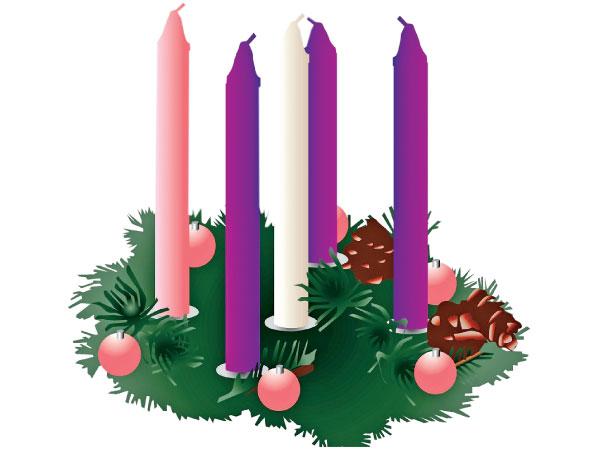
Advent
The period of Advent begins four Sundays before Christmas (December 25) and starts on November 30 or the Sunday closest to it. Advent is the start of the Christian Year. The English word Advent comes from the Latin word Adventus which means the ‘arrival’ or ‘coming’ meaning the coming of Jesus Christ.
During this period Christians prepare for the coming of Jesus whose birthday is celebrated on Christmas Day and remember the real meaning of Christmas. Long ago, Advent was linked to the Second Coming of Jesus Christ but in the Middle Ages it was linked to the First Coming of Jesus or his birth on Christmas Day.
Advent Candles and Wreaths
Advent candles are lit to count down the days to Christmas day.
The Advent Candle is like a normal candle but has the days from December 1 to December 25 notched or marked on it. Starting from December 1 the candle is lit and burnt down a notch or to the line marked for the first (the first line) and so on till Christmas on December 25 when the remaining part of the candle is lit and burnt down.
The Advent Wreath or Crown came into being in Germany in 1839 when a Lutheran Minister working with children built a wreath from a cartwheel. He placed 20 red candles and four white candles on it. The red candles were lit on weekdays and the white ones on Sundays. Then people started making Advent Wreaths or Advent Crowns out of evergreen branches.
Three purple candles and one pink candle is placed on the wreath with one white candle being fixed to the centre. This candle is also known as the Christ candle and it is lit on Christmas Eve or on Christmas Day itself and symbolises light and hope that came to the world with Jesus. The other four candles are lit during the four weeks of Advent. The rose candle is lit in the third week and these four candles symbolise many things and Churches give different meanings to these candles.
Christmas Cards
 Britisher Sir. Henry Cole started the tradition of sending Christmas cards in 1843. He was an employee in the newly set up Public Records Office (now Post Office) in UK. Postage was expensive and only the rich could afford to use the mail. Cole wondered how to let ordinary people use the postal system more and he and an artist friend Jim Horsley came up with the idea of Christmas cards.
Britisher Sir. Henry Cole started the tradition of sending Christmas cards in 1843. He was an employee in the newly set up Public Records Office (now Post Office) in UK. Postage was expensive and only the rich could afford to use the mail. Cole wondered how to let ordinary people use the postal system more and he and an artist friend Jim Horsley came up with the idea of Christmas cards.
Their first ever card had three panels with the two outer panels showing people helping the needy while the inner panel showed a family enjoying a huge Christmas dinner. This card was sold at a shilling each. As printing methods improved and postal rates became cheaper the popularity of the Christmas card increased.
By the early 1900s the tradition of sending Christmas cards had spread all over Europe and had become very popular in Germany. Early cards had nativity scenes and later pictures of robins and winter scenes. Christmas cards were available in the USA in the late 1840’ but were very expensive and most people could not afford them.
In 1875, Louis Prang, a Polishman living in Boston, mass produced Christmas cards and they became cheaper and everyone could afford them. Louis Prang is called the 'Father of the American Christmas card’. The first personalised Christmas cards were sent by Annie Oakley, star of Buffaloe Bill’s Wild West Show in 1891. While in Glasgow, Scotland she sent Christmas cards with her picture on them to her family and friends in USA.
The Advent Calendar
The Advent Calendar is supposed to have originated in the 19th Century with the first hand made calendar appearing in 1851.
In the late 19th century, a boy named Gerhard Lang was given Advent Calendars made of board with 24 tiny sweets stuck on them by his mother. Even as an adult Gerhard Lang remembered the thrill and excitement of receiving these calendars. So, in 1908, he and his business partner printed what is thought to be the first ever printed Advent Calendar with small pictures for each day in Advent. Later, they converted the pictures into little shuttered windows to make it more exciting.
Soon Advent Calendars became very popular and it is said that US President Dwight D. Eisenhower played a big role in popularising it in America. During World War 1 and 2 Advent Calendars could not be made due to cardboard being rationed but after the Second World War when rationing eased Richard Sellmer revived the tradition.
Today, Advent Calendars come in various forms and styles and are made from diverse materials. Most calendars have shuttered windows. Some may be even boxes with small cubby holes.
In the early days in these windows were nativity or winter pictures but today there are pictures of characters popular with children.
There can also be scripture verses or prayers printed in these little windows and little gifts such as chocolates. The first Advent Calendar with chocolates was produced in 1958 but did not catch on till the 1980s. Now, the Legoland Advent Calendar and Barbie Advent Calendars are very popular.
